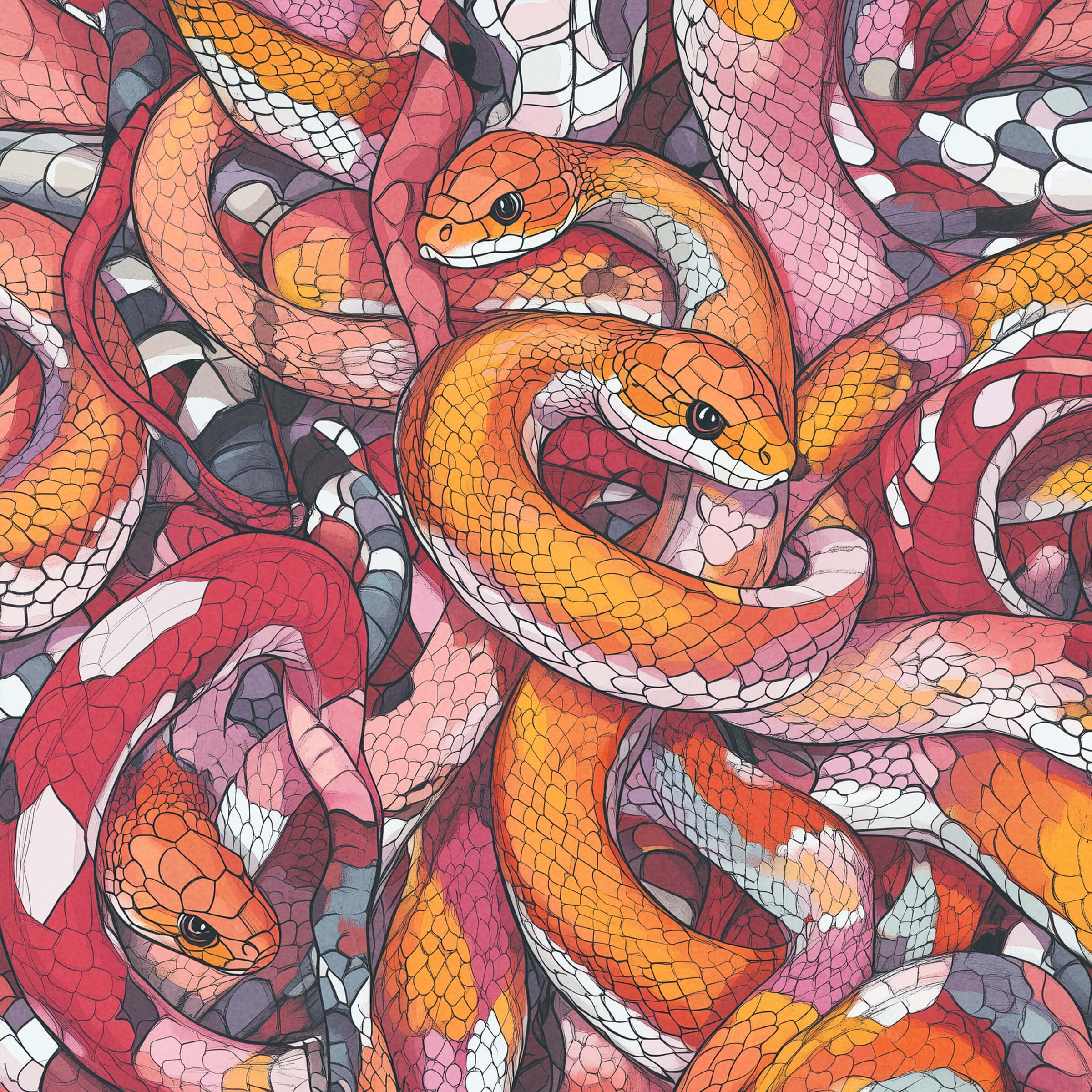
Killer Snakes, Frogs & Bugs: The Most Venomous Animals in the World
Venomous creatures are nature’s ultimate overachievers. They’ve spent millions of years fine-tuning their biochemical weapons to perfect the art of killing... efficiently, creatively, and often with a side of excruciating pain. But what’s truly fascinating (and a bit terrifying) is that these creatures aren’t just dangerous, they’re also shaping medical research, rewriting our understanding of biochemistry, and proving that nature really does know how to multitask.
So pull out your first-aid kit as we take you through 20 wild facts about the world’s most venomous creatures. By the end, you’ll either be thanking your lucky stars you’re not a small fish in the Indo-Pacific or wondering why you’re still reading about animals that can kill you with a single bite.
Note: A venomous creature actively delivers toxins through a bite, sting, or other means of injection (like snakes or spiders). In contrast, a poisonous organism releases toxins when eaten or touched (like certain frogs or plants). We’re focusing on the venom carriers, though like all things in nature, it’s not always that simple!
Oh, and don’t miss our "Top 10 Most Venomous Animals" roundup at the end...because who doesn’t love a good countdown?
The Box Jellyfish Can Kill You in Less Than Three Minutes
The Box Jellyfish holds the title for the deadliest marine animal. With venom that can shut down your heart and nervous system, a single sting can lead to cardiac arrest, paralysis, and excruciating pain.
Its long, tentacle-like appendages can stretch up to 10 feet, making it almost invisible in the water. If you're lucky enough to survive the sting, you’ll probably need more than a quick trip to the beach doctor (think more along the lines of immediate, life-saving intervention).

The Inland Taipan’s Venom Is 18 Times More Toxic Than an Indian Cobra’s
If you think all snakes are created equal, meet the Inland Taipan. Its venom is so toxic that a single bite can kill a human in under 30 minutes. With neurotoxins, anticoagulants, and myotoxins working together to paralyze and shut down organs, it’s an efficiency lesson in death. Lucky for us, the Inland Taipan prefers isolation in Australia’s desert... and anti-venom exists, so it’s more “likely” you’ll just hear about it in the news.

The Brazilian Wandering Spider Can Cause an Erection That Won’t Go Away
The Brazilian Wandering Spider’s venom is potent, causing paralysis, respiratory failure, and... let's get to it... priapism. Yes, a prolonged erection. It doesn’t stop there, though; this neurotoxin cocktail can cause extreme pain and dizziness, and sometimes death.
But don’t worry: anti-venom exists, and it’s really only a threat if you fail to treat it quickly. So, if you find one of these in your shoe, maybe leave it for the professionals to handle.
The Stonefish Might Kill You Just by Lying Around
The Stonefish is the master of disguise, blending into the ocean floor like an expert at hide-and-seek. But its venomous spines, which cause severe pain, paralysis, and sometimes death, don’t give it away.
A sting from this camouflaged assassin needs urgent attention, often involving hot water to neutralize the venom. Thankfully, these stone-cold killers aren’t likely to come after you, unless you step on one while barefoot.

The Geographic Cone Snail Could Kill You Without Even Trying
The Geographic Cone Snail is one of those creatures that seems way too chill to be deadly. Yet, its venomous harpoon tooth can paralyse a human within hours. The cocktail of peptides paralyzes its prey, and if you’re unlucky enough to get a dose, you’ll experience paralysis, respiratory failure, and death (unless medical attention arrives quickly). This little guy is a reminder that size doesn’t always matter when it comes to danger.

The Sydney Funnel-Web Spider Is Fast, Deadly, and Doesn’t Play Nice
This spider’s venom is a top-tier neurotoxin that causes muscle spasms, paralysis, and respiratory failure... effects that can kill a human within 30 minutes without anti-venom.
The male is particularly dangerous, packing ten times more venom than the female. Though fatalities have dropped thanks to anti-venom, this spider still manages to top the list of reasons to avoid eastern Australia’s bushland.

The Komodo Dragon Uses Venom to Weaken Its Prey
Komodo dragons have long been thought to rely on bacteria to weaken and kill their prey, but recent research reveals they have a secret weapon: venom. After biting, the venom triggers a drop in blood pressure and prevents blood clotting, essentially ensuring that the prey bleeds out.
Fortunately, the venom isn't a significant threat to humans, but it’s still useful for these giant lizards when chasing down their dinner.

The Marbled Cone Snail Can Paralyze and Kill in Seconds
Despite being a marine creature that looks like a pretty seashell, the Marbled Cone Snail delivers a venomous sting that can cause paralysis in a matter of seconds… and death soon after.
The snail injects neurotoxins, immobilizing its prey almost instantly. This rapid-acting venom serves as a stark reminder that even the smallest creatures can be the deadliest.

The Golden Poison Dart Frog Has Enough Poison to Kill Several Humans
Found in Colombia’s rainforests, the Golden Poison Dart Frog carries the most potent toxin of any amphibian on Earth. Batrachotoxin, the neurotoxin it secretes, can cause paralysis and heart failure.
Intriguingly, these frogs don’t make the toxin themselves; it comes from their diet of toxic ants and other invertebrates. If you were thinking of having one as a pet, you might want to reconsider.
Bonus Fact: Hemotoxic Newts Are Both Venomous and Poisonous
Hemotoxic newts (like the Spanish ribbed newt) are both venomous and poisonous. The venom is from its spines, and the poison is on its skin.

The Deathstalker Scorpion’s Sting Can Cause Excruciating Pain, Fever, and Death
This scorpion’s venom is as unpleasant as it sounds. A sting from the Deathstalker can bring on pain, fever, seizures, and even death... especially in vulnerable individuals.
While it’s rarely fatal to adults, it’s one of the most feared scorpions in the Middle East and North Africa. But hey, at least its venom is being explored for potential cancer treatments, so there’s that silver lining.

The King Cobra Can Kill an Elephant with One Bite
The King Cobra (the animal, not the G.I. Joe bad guy) doesn’t need to bite more than once. Its venom is so potent that a single strike delivers enough poison to kill an Asian elephant in three hours. These snakes inject 7-10 mL of venom at once, which leads to paralysis and respiratory failure.
Remarkably, they only use about 25% of their venom reserves on each strike... just enough to bring down a meal.

The Black Mamba Is One of the Fastest, Deadliest Snakes Around
The Black Mamba holds the title for the fastest snake, capable of striking up to 12 times in a single attack. Its venom, a potent mix of neurotoxins, causes paralysis and respiratory failure, with death possible in as little as 20 minutes.
The Black Mamba is aggressive and fast, but it's not just about speed... it’s about efficiency, too.

The Pufferfish’s Toxin Is 1,200 Times More Poisonous Than Cyanide
The Pufferfish's toxin, tetrodotoxin, is deadly enough to stop your heart. It’s found primarily in the liver and ovaries, and it blocks sodium channels in the body, causing paralysis and respiratory failure.
Despite this, the pufferfish is considered a delicacy in Japan. Only trained, licensed chefs are allowed to prepare it because even a tiny mistake could result in a fatal dose.

The Maricopa Harvester Ant’s Sting Is One of the Most Painful
The Maricopa Harvester Ant is small, but don’t let that fool you. Its sting is one of the most painful insect stings you can experience. Its venom causes an intense burning pain that can last for hours, and while it isn’t deadly, it’s a strong deterrent.
Just don’t provoke these ants (especially if you value your comfort).

The Yellow-Bellied Sea Snake Can Kill You in a Few Hours
Native to the Indo-Pacific, the Yellow-Bellied Sea Snake carries venom capable of paralyzing its prey quickly. The venom can cause respiratory failure in humans if not treated swiftly.
While they generally avoid humans, their venom is potent enough to be a threat when provoked.

The Black Widow Spider’s Venom Can Lead to Death if Untreated
The Black Widow Spider’s venom may cause muscle cramps and intense pain, but it can also be lethal if not addressed immediately. It contains a neurotoxin that affects the nervous system, leading to symptoms ranging from severe cramping to respiratory failure.
Luckily, with proper medical treatment, the chances of survival are very high.

The Blue Poison Arrow Frog’s Toxin Can Kill Small Animals
This frog from Suriname has skin that secretes a powerful toxin capable of killing small animals. The neurotoxin, batrachotoxin, is absorbed from the frog’s diet of ants and other small invertebrates.
While it doesn’t pose a major risk to humans in the wild, it’s another example of how brightly colored creatures sometimes hide dangerous surprises.

The Inland Taipan’s Venom Can Kill in Under 30 Minutes
This snake, native to Australia, possesses venom so potent that a single bite can kill a human in under 30 minutes.
Its venom contains neurotoxins that cause rapid organ failure, and though fatalities are rare due to its remote habitat and available antivenom, it’s still one of the deadliest snakes around.

The Scaly-foot Gastropod Uses Iron to Protect Itself
This deep-sea snail may seem harmless, but its iron-reinforced shell is an evolutionary marvel. It lives in extreme conditions, with high pressure and heat, and uses the iron to protect itself from predators and environmental toxins. Its shell is the ultimate form of defense in one of Earth’s most hostile environments.

The Trapdoor Spider’s Bite Can Cause Pain and Swelling
Though not life-threatening, the Trapdoor Spider’s bite can cause localized pain and swelling. Found in the southwestern United States, these spiders are territorial and will bite if threatened. Their venom helps immobilize prey, but it's no reason to freak out.

Top 10 Most Venomous Animals in the World Ranked - A Toxicology Hierarchy:
- Inland Taipan (Oxyuranus microlepidotus)
- Box Jellyfish (Chironex fleckeri)
- Blue-Ringed Octopus (Hapalochlaena spp.)
- Marbled Cone Snail (Conus marmoreus)
- Coastal Taipan (Oxyuranus scutellatus)
- Deathstalker Scorpion (Leiurus quinquestriatus)
- Eastern Brown Snake (Pseudonaja textilis)
- Boomslang (Dispholidus typus)
- Funnel-Web Spider (Atrax robustus)
- Brazilian Wandering Spider (Phoneutria nigriventer)
While these venomous creatures might be nature’s ultimate survivalists, their role in science and medicine proves that even the deadliest of animals can give us a leg up in understanding the world around us. But if you think this list was intense, just wait until you check out our other articles, like 11 Facts About Extreme Animals or High Flying Falcon Facts, where we dive into the bizarre and jaw-dropping abilities of creatures that can push the boundaries of what’s possible. Trust us, if you thought venom was wild, you haven’t seen anything yet.





